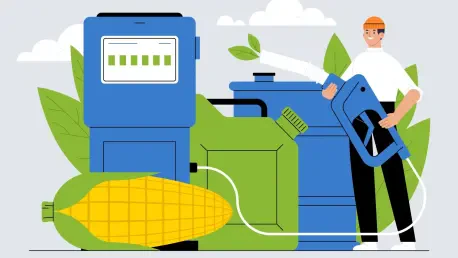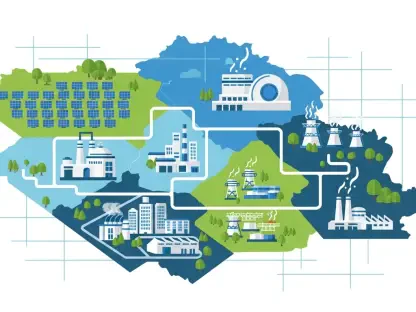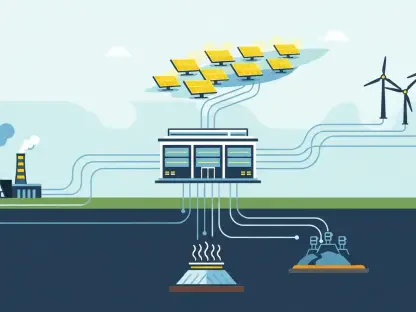Imagine a world where the transportation sector, a major contributor to global greenhouse gas emissions, slashes its carbon footprint by over 50% through a single innovation, and this isn’t a distant dream but a tangible reality shaped by biofuel technology, a renewable energy solution derived from organic materials. As climate change intensifies and energy security remains a pressing concern, biofuels offer a sustainable path forward, reducing reliance on fossil fuels. This review dives into the evolution, key features, and real-world impact of biofuel technologies across industries like transportation and aviation, highlighting their role in addressing global challenges.
Key Biofuel Types and Technologies
Bioethanol and Ethanol Blending Programs
Bioethanol, produced from feedstocks such as sugarcane, corn, and broken rice, stands as a cornerstone of renewable fuel initiatives worldwide. In regions like India, the Ethanol Blending Program (EBP) promotes blends like E10 and E20, mixing ethanol with gasoline for use in internal combustion engines. This approach not only curbs vehicular emissions but also reduces dependence on crude oil imports, aligning with national energy goals.
The significance of bioethanol extends beyond environmental benefits, as it supports agricultural economies by creating demand for crops. Performance metrics show consistent adoption rates, with many countries reporting a steady increase in blended fuel usage over recent years. Such programs demonstrate how bioethanol serves as a practical step toward cleaner transportation systems.
Biodiesel and Feedstock Innovations
Biodiesel production, aimed at blending with conventional diesel, faces hurdles in meeting ambitious targets. For instance, despite a 5% blending mandate in certain regions, actual uptake often hovers around 0.75–0.8% due to feedstock scarcity. This gap highlights the need for alternative solutions to bolster supply chains and achieve policy objectives.
Innovative feedstocks like Distilled Corn Oil (DCO), a co-product of corn-based ethanol production, emerge as a promising answer. DCO not only has the potential to meet blending targets but also strengthens agricultural value chains by adding economic value to byproducts. Trials of bio-C4 alcohol blends, such as isobutyl alcohol in diesel, further indicate progress in enhancing biodiesel’s role in cutting transportation emissions.
Compressed BioGas (CBG) and Circular Economy
Compressed BioGas (CBG), derived from organic waste like cattle dung and municipal solid waste, represents a purified form of biogas with properties similar to compressed natural gas (CNG). Promoted through initiatives like India’s SATAT scheme, CBG powers CNG vehicles and supports household and industrial heating needs. Its production process underscores a commitment to sustainable waste management.
Beyond energy generation, CBG contributes to a circular economy by curbing methane emissions from decomposing waste. It also fosters decentralized energy systems, particularly in rural areas, empowering local communities with accessible fuel sources. This dual benefit of environmental and social impact positions CBG as a vital component of green energy frameworks.
Sustainable Aviation Fuel (SAF) and Decarbonization
Sustainable Aviation Fuel (SAF), produced via Alcohol-to-Jet technology and waste oils, offers a groundbreaking solution for the aviation sector. Capable of reducing lifecycle emissions by 50–80%, SAF functions as a direct substitute for conventional jet fuel without necessitating engine modifications. This compatibility makes it a game-changer for an industry under pressure to decarbonize.
The adoption of SAF signals a shift toward sustainability in air travel, with several airlines integrating it into their operations to meet carbon neutrality goals. Performance tests confirm its reliability, ensuring that safety and efficiency remain uncompromised. As production scales, SAF holds promise for transforming aviation into a greener mode of transport.
Recent Advancements in Biofuel Technology
The biofuel sector has witnessed significant strides in recent times, particularly in feedstock innovation and processing efficiency. Solutions like DCO for biodiesel production address longstanding supply constraints, while trial programs for alternative blends expand the scope of fuel applications. These developments reflect a broader push to refine technologies and make biofuels more viable on a commercial scale.
Emerging trends also point to the integration of biofuels into comprehensive energy systems. Policy support in various regions, including incentives and mandates, drives growth, while advancements in scaling up Sustainable Aviation Fuel and CBG production capacities signal readiness for wider adoption. Such progress underscores a dynamic field poised for further breakthroughs.
Technological improvements are complemented by efforts to enhance sustainability across the production chain. From optimizing conversion processes to reducing energy inputs, the focus remains on maximizing environmental benefits. This holistic approach ensures that biofuels evolve as a cornerstone of modern energy strategies.
Real-World Applications of Biofuels
Biofuels have found practical deployment across diverse sectors, showcasing their versatility. Bioethanol, through blending with gasoline, powers millions of vehicles, significantly lowering emissions in urban and rural settings alike. Programs like ethanol blending initiatives exemplify how policy can translate into widespread impact on transportation.
In parallel, CBG supports rural energy needs and fuels CNG vehicles, providing a clean alternative for public and private transport. Biodiesel enhances diesel engine performance with reduced pollutants, while SAF paves the way for sustainable aviation. Notable examples include airlines adopting SAF to align with global carbon reduction targets, illustrating real-world efficacy.
These applications highlight the adaptability of biofuels to varying infrastructural and economic contexts. Whether in decentralized rural setups or high-demand aviation hubs, the technology proves its relevance. Such diverse use cases reinforce the argument for continued investment and innovation in this field.
Challenges and Limitations in Biofuel Adoption
Despite its potential, biofuel adoption grapples with significant obstacles, including feedstock availability. Limited access to raw materials, especially for biodiesel, hampers efforts to meet blending targets, creating a bottleneck in scaling operations. This scarcity often stems from competing demands for agricultural resources.
Infrastructure gaps further complicate the landscape, as production and distribution networks require substantial investment. Regulatory and market challenges, such as delays in certifying new feedstocks like DCO, slow down progress. These hurdles necessitate coordinated efforts between policymakers and industry stakeholders to streamline implementation.
Ongoing initiatives, including field trials and partnerships with oil marketing companies, aim to address these limitations. Yet, the path forward demands sustained commitment to overcome financial and logistical barriers. Without such resolve, the full potential of biofuels risks remaining untapped in critical sectors.
Future Outlook for Biofuel Innovations
Looking ahead, biofuel technology stands on the cusp of transformative growth through feedstock diversification and enhanced production methods. Expanding the range of raw materials can mitigate supply constraints, while scaling SAF output promises to redefine aviation sustainability. These advancements could reshape global energy frameworks over the coming years.
The long-term impact of biofuels extends to energy security and rural economic development, especially in agrarian economies. By fostering local production, biofuels can drive job creation and income stability in underserved regions. This socioeconomic benefit aligns with broader climate goals, creating a synergy of progress.
Integration into international energy policies also appears imminent, as biofuels gain recognition as a resilient solution. Continued research into efficiency and scalability will likely unlock new applications, ensuring accessibility across diverse markets. This trajectory suggests a pivotal role for biofuels in shaping a sustainable energy future.
Final Thoughts
Reflecting on the journey of biofuel technology, it becomes evident that its diverse applications have carved a niche in transportation, aviation, and rural energy sectors. The environmental and economic benefits stand out as compelling reasons for its adoption, despite persistent challenges like feedstock constraints and infrastructure needs. Each type, from bioethanol to SAF, has demonstrated unique strengths in curbing emissions and fostering sustainability.
Moving forward, actionable steps emerge as critical to sustaining this momentum. Accelerating certification processes for innovative feedstocks, expanding field trials, and bolstering investment in distribution networks offer practical solutions. Additionally, forging stronger collaborations between governments and private entities could bridge existing gaps, ensuring biofuels become an integral part of global energy systems for years to come.









